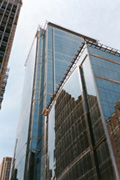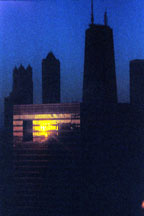|
|
Only the young Frank Lloyd Wright resisted Burnham's
siren song, and he paid for it with decades of exile. The moment he turned
down Burnham's offer of six years of all-expenses-paid classical training
in Paris and Rome, Wright recounts in his autobiography, he saw his commitment
to an organic American architecture grow clear, even as he assumed--not
altogether uncomfortably--the mantle of the outsider.
As conditions allowed, Wright continued his quest, building great homes
in Oak Park, Robie House
and Midway Gardens in Chicago, and the Imperial Hotel in Japan--so technologically
advanced that it survived the great earthquake of 1922. The publication
of Wright's work in Berlin in 1910 made him, for the moment, more widely
known in Europe than in the States. Dutch architect H.P. Berlage wrote
that the two most impressive things he saw on his American tour were Niagara
Falls and Wright's Larkin
Building in Buffalo. Architects such as J.J.P. Oud were deeply influenced
by Wright's search for purity and simplicity, and while Wright soon found
their buildings straying from his own idea of the organic, more and more
Europeans strove for the honest expression of function and structure.
But only when the rise of the Third Reich chased the great architects
of Europe from their own countries did modern architecture make its way
back to the shores of Lake Michigan--in the person of Ludwig Mies van
der Rohe.
In Germany Mies's most ambitious projects had seldom got beyond drawings
on paper, but Chicago provided him with the great patrons he needed. The
Armour Institute--which would become IIT--brought him over to head its
architecture school and to redesign its campus. Developer Herbert Greenwald,
a former rabbinical scholar, commissioned the 860-880
Lake Shore Drive apartments, Chicago's first skyscrapers since the
onset of the Great Depression and the leading examples of a new way of
building: the steel structure expressed directly in the facade, with exterior
walls composed entirely of windows.
Mies was the anti-Burnham. Burnham's mode was accretive--Roman columns,
classical pediments--and Mies's was reductive. At the beginning, he would
tell his students, eliminate nothing, consider every possibility. Then
reduce and simplify, relentlessly, until only the one, essential, irrefutable
solution remains.
Mies knew his Sullivan--he knew what a tall building was all about. There's
poetry in how a Mies classic like the IBM
Building (330 N. Wabash) floats above its recessed lobby, emphasizing
the cleavage between the structural columns and the nonstructural curtain
wall; in the way the applied I-beam mullions reflect the structural elements;
in how the plaza provides the building a pedestal, giving it room to breathe
and be seen. This is how Mies found a solution to the problem of the tall
building, just as Sullivan and Root had done before.
Chicago's Jacques Brownson took it a step further. At his Chicago Civic
Center (now the Daley
Center, at Clark and Randolph) he did away with the curtain wall,
composing the facade of the actual beams and columns, finished in self-oxidizing
Cor-Ten steel. The structural spans have been described as more like those
of a bridge than a building, able to leap a city block in just three 87-foot-wide
bays.
Taking an innovative idea to a breathtaking extreme--to quote Sean Connery,
"that's the Chicago way."
Can the faceless new high-rises really be the buildings that are bringing
people back to Chicago's downtown? Would anybody be moving back to the
city if the only view out their window were of buildings like their own?
No--people come back to be able to look out their window and see that
defining skyline: the sleek romance of the Hancock,
the four squat lanterns of 900
N. Michigan, the cubist slices of One
Magnificent Mile, IBM's black citadel, the AMA's
sky-pierced feng shui notch, the bleached Spanish tower of the Wrigley,
the flying buttresses of Tribune
Tower, the cool aluminum grid of the Equitable,
the gold-tipped Carbon
& Carbide, the glowing dome and cupolas of 35 E. Wacker, the upward
swoop of Bank
One, the bison-flanked glowing blue beehive of the Straus
Building, the sweeping emerald curve of
333 W. Wacker, Boeing's sleek clock tower, 311
S. Wacker's loopy beacon crown, the stacked superlative of Sears
Tower. Great buildings, good buildings, silly buildings--but all integral
parts of the visual mosaic that is what people mean when they say Chicago.
How, with such a rich legacy to draw on, has Chicago architecture lost
its character? It's not just a matter of cost. In 1906, Wright persuaded
Unitarian church trustees in Oak Park that bare concrete was not just
the best solution for their project but the only one that fit their bare-bones
budget. Yet he didn't simply copy in concrete the ubiquitous gothic rockpile
of his day. He rethought form and function and created one of architecture's
universally acknowledged masterpieces, the Unity
Temple.
Yet the graceless concrete towers rising today all fall into the category
of commodity buildings, architectural fill. This is what most buildings
are, and always have been--structures of little distinction that serve
their limited purpose. In the past the trophy buildings of the day, the
buildings with personality and consequence, always overshadowed the fill.
But now new trophy buildings are rare. The dot-com collapse and corporate
consolidation have left a dearth of big-name corporations in need of an
architectural calling card. And when the need does exist, corporations
don't build--they swap. Amoco is dead, so Aon takes over the space and
the building's name. Boeing moves its headquarters to Chicago and slaps
its logo on the futuristic clock tower Ralph Johnson designed for Morton
International. Even Cook County consolidated its office space by buying
the former headquarters of the Brunswick Corporation.
New commercial space is mostly stuffed into anonymous towers west of the
river. Of the three office skyscrapers that have been added to the Loop,
one,  Ricardo
Bofill's Dearborn Center (131 S. Dearborn), is a disaster--a Botero-esque
bloat of steel and darkened glass sucking up light and life from the streets
around it. Gerald D. Hines's 191
N. Wacker, designed by Kohn Pederson Fox, is an inoffensively anonymous
glass tower falling far below the standards of the folks who gave us 333
W. Wacker. Only James Goettsch's elegant UBS
Tower (1 N. Wacker), with its cable-and-glass lobby wall and block-long
row of Seussian planters, deserves a place in the city's permanent portfolio. Ricardo
Bofill's Dearborn Center (131 S. Dearborn), is a disaster--a Botero-esque
bloat of steel and darkened glass sucking up light and life from the streets
around it. Gerald D. Hines's 191
N. Wacker, designed by Kohn Pederson Fox, is an inoffensively anonymous
glass tower falling far below the standards of the folks who gave us 333
W. Wacker. Only James Goettsch's elegant UBS
Tower (1 N. Wacker), with its cable-and-glass lobby wall and block-long
row of Seussian planters, deserves a place in the city's permanent portfolio.

 |
Page: |
|
|
|
|
|
Lynnbecker@lynnbecker.com
© Copyright 2003-2004 Lynn
Becker All rights reserved.
|



